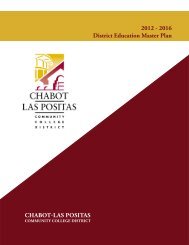City College of San Francisco - California Competes
City College of San Francisco - California Competes
City College of San Francisco - California Competes
You also want an ePaper? Increase the reach of your titles
YUMPU automatically turns print PDFs into web optimized ePapers that Google loves.
THEME II<br />
There were significant indicators that the Department needed do something about this situation. Pass rates<br />
were not only lower than desired, but varied considerably by section and instructor; there were serious<br />
retention issues; and there was a common perception supported by some statistical evidence that significant<br />
numbers <strong>of</strong> the students coming out <strong>of</strong> English 94 were not adequately prepared to be successful in<br />
subsequent courses. In Fall 1999, a few faculty proposed a common, holistically graded in-class essay for<br />
English 94 as the first step in determining what was going on in this “problem class.” From the outset,<br />
one important and unusual feature <strong>of</strong> the proposal was that this exam was not to be given in lieu <strong>of</strong> a final<br />
exam or account for a large portion <strong>of</strong> a student’s course grade. This was in response to the Department<br />
and <strong>College</strong>’s collective memories <strong>of</strong> a common exit essay test given in English 1A some 15 years earlier<br />
that resulted in much lower pass rates and negatively affected graduation and transfer rates for the several<br />
years it was in place. The English 94 common exam proposal specified that the exam was to take place<br />
during week 12 <strong>of</strong> the semester and was not to be a final, summative, “barrier” exam.<br />
The proposal still galvanized several different factions among the 100+ faculty in the English Department. 7<br />
However, the faculty proponents <strong>of</strong> the common exam found that very few <strong>of</strong> the opponents were actually<br />
teaching English 94. The English 94 instructors knew that what was happening at the 94 level—both in<br />
class and with regard to student outcomes—was not working well. They were losing 43 percent <strong>of</strong> their<br />
students over the course <strong>of</strong> the semester; even after first census, the classes lost 29 percent <strong>of</strong> their enrollment.<br />
In addition, the success rates for students who did complete the class were in need <strong>of</strong> improvement,<br />
ranging from 54 percent to 65 percent. 8 The faculty responsible for teaching English 94 felt compelled to<br />
come together to determine what needed to be prioritized in the course and then work together to make<br />
the course a more effective bridge to future success for the students.<br />
The process and the lessons. In Spring 2000, a pilot <strong>of</strong> the common exam was conducted by a limited<br />
number <strong>of</strong> volunteer faculty. They carefully developed protocols for administering the exam and developed<br />
a holistic rubric grounded in the outcomes established in the existing course outline <strong>of</strong> record. The<br />
results <strong>of</strong> this first effort were startling. Only 32 percent <strong>of</strong> the students taking the common exam were<br />
judged to have met the threshold for success established in the rubric. However, in that same semester,<br />
over 64 percent <strong>of</strong> the students received passing grades. It was clear to the faculty that they needed to<br />
revise the rubric downward; that is, the rubric set the expectations too high. More significantly, it was<br />
also clear that the existing course outline did not reflect what students were capable <strong>of</strong> learning when they<br />
entered English 94. A second pilot was undertaken in the Spring <strong>of</strong> 2001. This time all sections <strong>of</strong> English<br />
94 were tested and some <strong>of</strong> the procedural problems were rectified. While the pass rates were still only<br />
32 percent, a follow-up survey revealed that faculty and students found the common exam process to be<br />
positive and valuable. The dichotomy between the common exam pass rates and the overall course pass<br />
rates could be partially attributed to the limitations inherent in using a single writing sample, particularly<br />
a timed in-class writing sample. However, it was also clear to the faculty that the course outline did not<br />
provide a reasonable set <strong>of</strong> expectations and, as a result, each teacher was creating his or her own set <strong>of</strong><br />
outcomes expectations.<br />
The response to this single effort to develop a more useful assessment <strong>of</strong> student learning has been pr<strong>of</strong>ound<br />
for the English Department. The most obvious immediate implication was the need to thoroughly<br />
review and revise the course outline for English 94 to make it consistent with what students are capable<br />
<strong>of</strong> accomplishing in a single course at this level <strong>of</strong> their developmental process. However, English 94 sits<br />
in the middle <strong>of</strong> a sequence <strong>of</strong> five levels <strong>of</strong> reading and writing classes designed to prepare students for<br />
college-level, university transfer writing, and critical thinking coursework. If English 94 were going to be<br />
revised, and the primary objective <strong>of</strong> this revision was to provide more clearly articulated and realistic<br />
7 Approximately 65 faculty are full-time and 35-40 are part-time; about 75 percent <strong>of</strong> the sections are taught by full-time faculty.<br />
8 Spring semester pass rates tend to be higher than fall semester pass rates and fluctuate considerably from year to year.<br />
CITY COLLEGE OF SAN FRANCISCO<br />
267







